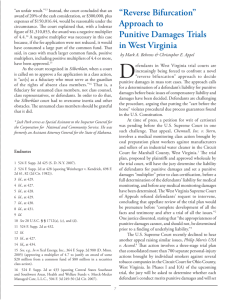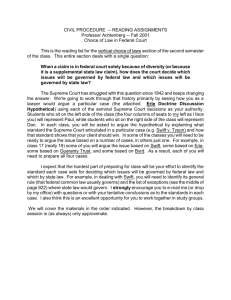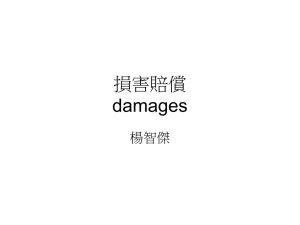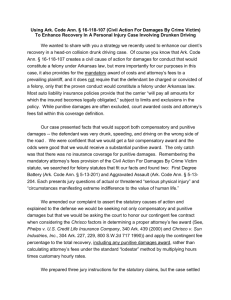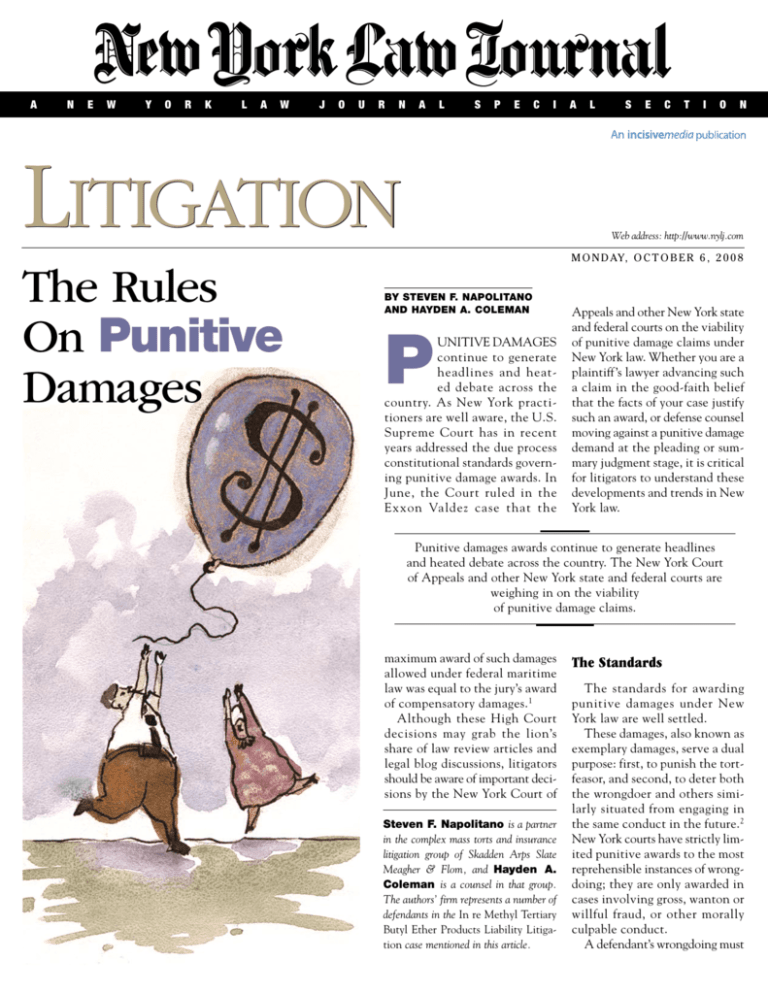
N
EA W
N
EY WO
R Y KO
R
LK
A L WA
W J
JO
OU U R R N N AA
L
S S P P E EC
CI
Litigation
The Rules
On Punitive
Damages
AI
LA
LS
E SC
TE
IC O T N I
Web address: http://www.nylj.com
M o n d ay, O c t o b e r 6 , 2 0 0 8
By Steven F. Napolitano
and Hayden A. Coleman
P
UNITIVE DAMAGES
continue to generate
headlines and heated debate across the
country. As New York practitioners are well aware, the U.S.
Supreme Court has in recent
years addressed the due process
constitutional standards governing punitive damage awards. In
June, the Court ruled in the
Exxon Valdez case that the
Appeals and other New York state
and federal courts on the viability
of punitive damage claims under
New York law. Whether you are a
plaintiff’s lawyer advancing such
a claim in the good-faith belief
that the facts of your case justify
such an award, or defense counsel
moving against a punitive damage
demand at the pleading or summary judgment stage, it is critical
for litigators to understand these
developments and trends in New
York law.
xxxxxxxxxxxxxx
Punitive damages awards continue to generate headlines
and heated debate across the country. The New York Court
of Appeals and other New York state and federal courts are
weighing in on the viability
of punitive damage claims.
xxxxxxxxxxxxxx
maximum award of such damages
allowed under federal maritime
law was equal to the jury’s award
of compensatory damages. 1
Although these High Court
decisions may grab the lion’s
share of law review articles and
legal blog discussions, litigators
should be aware of important decisions by the New York Court of
Steven F. Napolitano is a partner
in the complex mass torts and insurance
litigation group of Skadden Arps Slate
Meagher & Flom, and Hayden A.
Coleman is a counsel in that group.
The authors’ firm represents a number of
defendants in the In re Methyl Tertiary
Butyl Ether Products Liability Litigation case mentioned in this article.
The Standards
The standards for awarding
punitive damages under New
York law are well settled.
These damages, also known as
exemplary damages, serve a dual
purpose: first, to punish the tortfeasor, and second, to deter both
the wrongdoer and others similarly situated from engaging in
the same conduct in the future.2
New York courts have strictly limited punitive awards to the most
reprehensible instances of wrongdoing; they are only awarded in
cases involving gross, wanton or
willful fraud, or other morally
culpable conduct.
A defendant’s wrongdoing must
Monday, October 6, 2008
New York Law Journal
be more than intentional, and must evince “a
high degree of moral turpitude and demonstrate[] such wanton dishonesty as to imply a
criminal indifference to civil obligations.”3
Simple negligence or bad behavior will not
support a punitive award under New York
law, regardless of the underlying theory of
recovery pleaded.
Whether the defendant’s conduct meets
this high bar justifying punitive damages is,
of course, where plaintiff ’s and defendant’s
counsel inevitably part company. Representing a badly injured claimant, a plaintiff ’s
counsel may be convinced that a multimillion dollar punitive award is justified.
On the other hand, defense counsel may
well see a demand for punitive damages as
nothing more than a baseless, even “knee
jerk” litigation tactic, and may move to
dismiss the demand on the grounds that
the behavior alleged, even if proven, is not
the kind of malicious conduct justifying
punitive damages.
In other cases, the battleground for
punitive damages may be at the summary
judgment stage. As discussed below, courts
applying New York law have not hesitated to
dismiss punitive damage claims before trial
where they are unsupported by the facts.
Wrongful Adoption
In Ross v. Louise Wise Services, the New York
Court of Appeals addressed the viability of
punitive damages in the context of a “wrongful adoption” case.
The plaintiff-parents brought claims
against the defendant-adoption agency
alleging that the agency wrongfully withheld pertinent medical history regarding
the child they adopted in 1961. Despite
the plaintiffs’ statement that they wanted
to adopt “a healthy infant from a healthy
family,” the child they adopted was actually born to parents with significant
histories of emotional disturbance and
mental illness.
Years later, after their then-adult son
was diagnosed as a paranoid schizophrenic,
the plaintiffs asserted claims for wrongful
adoption/fraud, negligence and breach of
fiduciary duty, and intentional infliction of
emotional distress. The Court of Appeals,
noting that the defendant-agency concededly misrepresented facts about the child’s
background, affirmed the ruling below that
the parents had presented sufficient triable
facts on their fraud claim for compensatory damages.
However, the Court reversed the Appellate Division, First Department ruling affirming the trial court’s denial of the defendants’
motion for summary judgment with respect
to the claim for punitive damages. The Court
reiterated the fundamental standards that
punitive damages may only be awarded as a
matter of New York law to punish conduct
that was deliberate “‘and has the character of
outrage frequently associated with crime.’”4
The Court of Appeals concluded that “even
if [the defendant’s] failure to disclose may
have been tortious, its conduct in connection with the adoption did not evince the
high degree of moral turpitude required for
punitive damages. Nor would punitive damages be warranted against the Agency for
deterrence.”5
The Court explained that the plaintiffs’
complaint “includes a single cause of action
for wrongful adoption and fraud at the time of
the adoption.”6 Therefore, the reprehensibility
of defendant’s conduct must be evaluated
under the prevailing norms in the early 1960s
when the adoption took place.
The Court noted that the defendant’s
policies were in line with the then-current
thinking on both the cause of mental illness
(nurture more significant than nature) and how
adoptions should best be handled (disclosure
of negative medical information to adoptive
parents was to be avoided). Thus, the Court
concluded that the defendant’s conduct was
not malicious or vindictive in light of the prevailing norms, even though those norms no
longer reflect the current thinking on mental
illness or adoption policies.
Accordingly, a claimant should be precise
in defining the time period of the conduct
allegedly justifying punitive damages. In
cases where the conduct at issue happened
many years ago, as is often the case in the
toxic tort context, a plaintiff must be prepared to show that the conduct was outrageous based on the norms and knowledge
then prevailing.
Defense counsel may seek to engage an
expert witness to establish that the conduct
was not sufficiently malicious or vindictive
at the time. Finally, if circumstances have
changed so that the allegedly offending
conduct could not happen today, as with a
change in the law, defense counsel may properly assert that the goal of deterring future
improper conduct cannot be satisfied.
Regardless of whether you are the
proponent or opponent of the punitive
damage claim, preparation, including the
retention of expert witnesses, may be
necessary to build a proper record for
the court to determine whether punitives
can be recovered.
Residential, Hotel Injury Cases
Some of the more common cases where
punitive damages have been recovered in
New York have been in the landlord-tenant context.
For example, in Solis-Vicuna v. Notias,7 a
mother and her infant daughters sued the
defendant building owners alleging lead
paint poisoning of the children while they
resided in the building. After the jury rendered a verdict in the infants’ favor, awarding
them $380,000 and $420,000, respectively,
for future pain and suffering, and imposing
punitive damages in the amount of $260,000,
the building owners moved under CPLR 4404
to set aside the verdict and to dismiss the
punitive damages findings, or alternatively,
to reduce the punitive award as excessive.
The trial court held that the punitive
award was supported under the facts of the
case, finding that there was clear and convincing evidence to show that the defendants
were aware of the dangers of lead given the
presence of children in the apartment. Several inspections of the premises were conducted by the Department of Health, and
the defendants were notified of a dangerous
lead condition by an order to abate on several occasions. The defendants’ knowledge
of the lead hazard and failure to take action
were found adequate to support the punitive
damage award.
Additionally, the Solis-Vicuna court, citing
the U.S. Supreme Court’s ruling in BMW
of North America Inc. v. Gore, 8 held that the
amount of punitive damages awarded was not
excessive when compared with the compensatory damages awarded. The court held that
there was sufficient evidence of reprehensible conduct and noted that the punitive
award, less than one third of the compensatory award, was not disproportionate.
In another lead paint case, Morris v. Flaig,9
former tenants sued their landlords alleging
violations of New York law and the federal Residential Lead-Based Paint Hazard
Reduction Act (RLPHRA), alleging that
their daughter’s diagnosis of pervasive devel-
Monday, October 6, 2008
New York Law Journal
opmental disorder was caused by lead paint at
their Brooklyn residence. The district court
granted summary judgment to the landlords
as to the tenants’ claims for constructive
eviction, negligent infliction of emotional
distress, and nuisance.
After the jury found the landlords liable
for negligence and breach of the implied warranty of habitability and awarded the tenants $5,268 in compensatory damages and
$110,000 in punitive damages, the tenants
moved for partial judgment notwithstanding
the verdict, and the defendants moved for
judgment as a matter of law and for remittitur
of the punitive damages award. District Judge
Joseph Bianco held that “[a]lthough claims
for breach of the implied warranty of habitability sound in contract, they are dramatically different from breach of contract claims
arising from breach of privately negotiated
agreements.”10 The court recognized that:
The rights implied into all rental agreements in New York under RPL §235-b
are non-waivable, and directly address
concerns of health and public safety,
and deterring landlords from committing egregious violations of the implied
warranty of habitability directly serves
the public interest.… Indeed, a number
of New York courts have historically
permitted punitive damages for wanton violations of the implied warranty
of habitability (citation omitted).11
However, the district court did find that
the punitive award, more than 20 times the
compensatory award, was grossly excessive
under both state law and the federal constitutional standards enunciated by the U.S.
Supreme Court, and the punitive award was
conditionally remitted to $50,000.
Unlike the residential lead paint cases
discussed above, in Grogan v. Gamber Corp.,12
a case of first impression in New York, the
Supreme Court, New York County denied
recovery of punitive damages for injuries
allegedly caused by hotel bedbug bites.
The plaintiffs brought suit against both
the hotel owner and the hotel exterminators
with whom the hotel had a service contract,
alleging that “the presence of bedbugs was
tolerated and defendants’ indifference to this
condition [was] evident from their haphazard
procedures in treating infected rooms and
those adjacent at/or near them.”13
Moving for summary judgment, the defendants argued that even if the plaintiffs could
prove all of their claims at trial, they still
could not meet New York’s high threshold for
punitive damages. In order to establish their
claims, the plaintiffs relied on an affidavit of
a professor of medicine who also possessed
a doctorate in entomology.
The trial court nevertheless granted summary judgment on the punitive claim, recognizing that punitive damages are limited
to reprehensible actions that rise almost to
the level of a crime. The court distinguished
a bedbug case from the Seventh Circuit 14
which permitted punitive damages, holding that while the violations in that case
involved violations of a state statute and city
code, and the hotel owner there rented out
rooms knowing that they had live, feeding
bedbugs, “[a]t bar, the issues of culpability
relate to negligence only.”15
Accordingly, a claimant in a lead paint,
bedbug or other personal injury case must
establish knowledge of a serious risk to health
and a conscious disregard of the hazard to
support his demand for punitive damages.
Personal, first hand knowledge of the hazard and persons at risk, such as seen in the
landlord-tenant cases, is critical.
Market Share Liability Cases
Finally, in a ruling of great interest to the
mass tort bar, district judge Shira Scheindlin ruled last fall in In re Methyl Tertiary Butyl
Ether (“MTBE”) Products Liability Litigation,16 a
case in which the authors’ firm represents
a number of defendants, that punitive damages could not be recovered where New York
claimants relied on market share liability to
prove causation.
In the MTBE multidistrict litigation,
the plaintiffs sued a number of defendant
corporations for damages stemming from
contamination, or threatened contamination, of their groundwater with MTBE, a
chemical added to gasoline. Converting the
defendants’ Rule 56 motion into a motion
in limine, Judge Scheindlin held that while
“[m]arket share liability has the effect of
placing the burden on the defendant to
prove that it did not cause a particular
harm,” a New York claimant seeking to
recover punitive damages “should also be
required to identify the defendants that
caused the harm rather than lumping all
defendants together to find the deepest
pocket among them.” 17
The district court concluded that allowing punitive damages where a claimant is
relying on market share liability would be
inconsistent with Hymowitz v. Eli Lilly and
Co. , 18 New York’s leading case on market
share liability.
Conclusion
While keenly following the U.S. Supreme
Court’s important pronouncements concerning federal limitations on punitive damage
awards, New York practitioners should also
keep a watchful eye on important punitive
damage rulings under New York law.
Recent decisions offer important guidance
on how a punitive claim must be pleaded
and proven by plaintiffs, and how defense
counsel can succeed in many cases in having
a punitive demand dismissed before trial as
insufficient as a matter of law or factually
unsupported.
New York’s high bar for punitive damages
requires that practitioners focus from the
very onset of litigation on the elements of
a successful punitive damage claim and how
to defend against such a demand.
•••••••••••••
••••••••••••••••
1. Exxon Shipping Co. v. Baker, 128 S. Ct. 2605
(2008).
2. Ross v. Louise Wise Servs. Inc., 8 N.Y.3d 478, 489
(2007).
3. Walker v. Sheldon, 10 N.Y.2d 401, 405 (1961). See
also Randi A.J. v. Long Island Surgi-Ctr., 842 N.Y.S.2d 558,
564 (2d Dept. 2007) (“Courts in this State have long recognized that those who, without specifically intending
to cause harm, nevertheless engage in grossly negligent
or reckless conduct showing an utter disregard for the
safety or rights of others, may also be deserving of the
imposition of punitive damages.”).
4. Ross at 489 (quoting Prozeralik v. Capital Cities
Communications Inc., 82 N.Y.2d 466, 479 (1993)).
5. Id. at 490. In 1983, the Legislature enacted Social
Services Law §373-a requiring the disclosure of medical
histories to preadoptive parents and adult adoptees. The
law was amended in 1985 to include adoptive parents.
6. Id. at 491 (emphasis added).
7. No. 17769/2002, slip op., 2008 WL 2513656 (N.Y.
Sup. Ct. Kings County June 23, 2008).
8. 517 U.S. 559 (1996).
9. 511 F. Supp. 2d 282 (E.D.N.Y. 2007).
10. Id. at 297.
11. Id.
12. 19 Misc. 3d 798 (N.Y. Sup. N.Y. County 2008).
13. Id. at 803.
14. Mathias v. Accor Econ. Lodging Inc., 347 F.3d 672
(7th Cir. 2003).
15. 19 Misc. 3d at 808.
16. 517 F. Supp. 2d 662 (S.D.N.Y. 2007).
17. Id. at 662.
18. 73 N.Y.2d 487 (1989).
Reprinted with permission from the October 6, 2008 edition
of the New York Law Journal © 2008 ALM Properties, Inc.
All rights reserved. Further duplication without permission
is prohibited. For information, contact 877-257-3382 or
reprintscustomerservice@incisivemedia.com. ALM is now
Incisive Media, www.incisivemedia.com. # 070-10-08-0008


